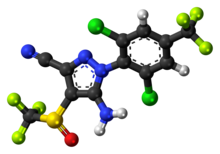
| |

| |
| Names | |
|---|---|
| Preferred IUPAC name
5-amino-1-[2,6-dichloro-4-(trifluoromethyl)phenyl]-4-(trifluoromethylsulfinyl)pyrazole-3-carbonitrile[1] | |
| Other names
Fipronil
Fluocyanobenpyrazole Taurus Termidor | |
| Identifiers | |
3D model (JSmol)
|
|
| ChEBI | |
| ChEMBL | |
| ChemSpider | |
| ECHA InfoCard | 100.102.312 |
| KEGG | |
PubChem CID
|
|
| UNII | |
CompTox Dashboard (EPA)
|
|
| |
| |
| Properties | |
| C12H4Cl2F6N4OS | |
| Molar mass | 437.14 g·mol−1 |
| Density | 1.477-1.626 g/cm3 |
| Melting point | 200.5 °C (392.9 °F; 473.6 K) |
| Pharmacology | |
| QP53AX15 (WHO) | |
| Hazards | |
| GHS labelling: | |
  
| |
| Danger | |
| NFPA 704 (fire diamond) | |
| Lethal dose or concentration (LD, LC): | |
LD50 (median dose)
|
97 mg/kg (rat, oral) |
LC50 (median concentration)
|
0.25 mg/L (rainbow trout, aquatic) |
| Safety data sheet (SDS) | Fipronil |
Except where otherwise noted, data are given for materials in their standard state (at 25 °C [77 °F], 100 kPa).
| |
Fipronil is a broad-spectrum insecticide that belongs to the phenylpyrazole chemical family. Fipronil disrupts the insect central nervous system by blocking the ligand-gated ion channel of the GABAA receptor and glutamate-gated chloride (GluCl) channels. This causes hyperexcitation of contaminated insects' nerves and muscles. Fipronil's specificity towards insects is believed to be due to its greater binding affinity for the GABAA receptors of insects than to those of mammals, and for its action on GluCl channels, which do not exist in mammals.[3] As of 2017[update], there does not appear to be significant resistance among fleas to fipronil.[4]
Because of its effectiveness on various pests, fipronil is used as the active ingredient in flea control products for pets and home roach baits as well as field pest control for corn, golf courses, and commercial turf. Its widespread use makes its specific effects the subject of considerable attention. Observations on possible harm to humans or ecosystems are ongoing as well as the monitoring of pesticide resistance development.[5]
- ^ Cite error: The named reference
PubChemwas invoked but never defined (see the help page). - ^ "Safety Date Sheet" (PDF). Santa Cruz Biotechnology, Inc. 23 April 2019. SC-201546 - Fipronil. Retrieved 30 October 2023.
- ^ Raymond-Delpech, Valérie; Matsuda, Kazuhiko; Sattelle, Benedict M.; Rauh, James J.; Sattelle, David B. (2005). "Ion channels: molecular targets of neuroactive insecticides". Invertebrate Neuroscience. 5 (3–4): 119–133. doi:10.1007/s10158-005-0004-9. ISSN 1354-2516. PMID 16172884. S2CID 12654353.
- ^ Todd-Jenkins, Karen (18 June 2017). "Perception Versus Reality: Insecticide Resistance in Fleas". American Veterinarian. 2 (3). Archived from the original on 11 April 2020.
{{cite journal}}: CS1 maint: unfit URL (link) - ^ Maddison, Jill E.; Page, Stephen W. (2008). Small Animal Clinical Pharmacology (2nd ed.). Elsevier Health Sciences. p. 229. ISBN 978-0-7020-2858-8.
